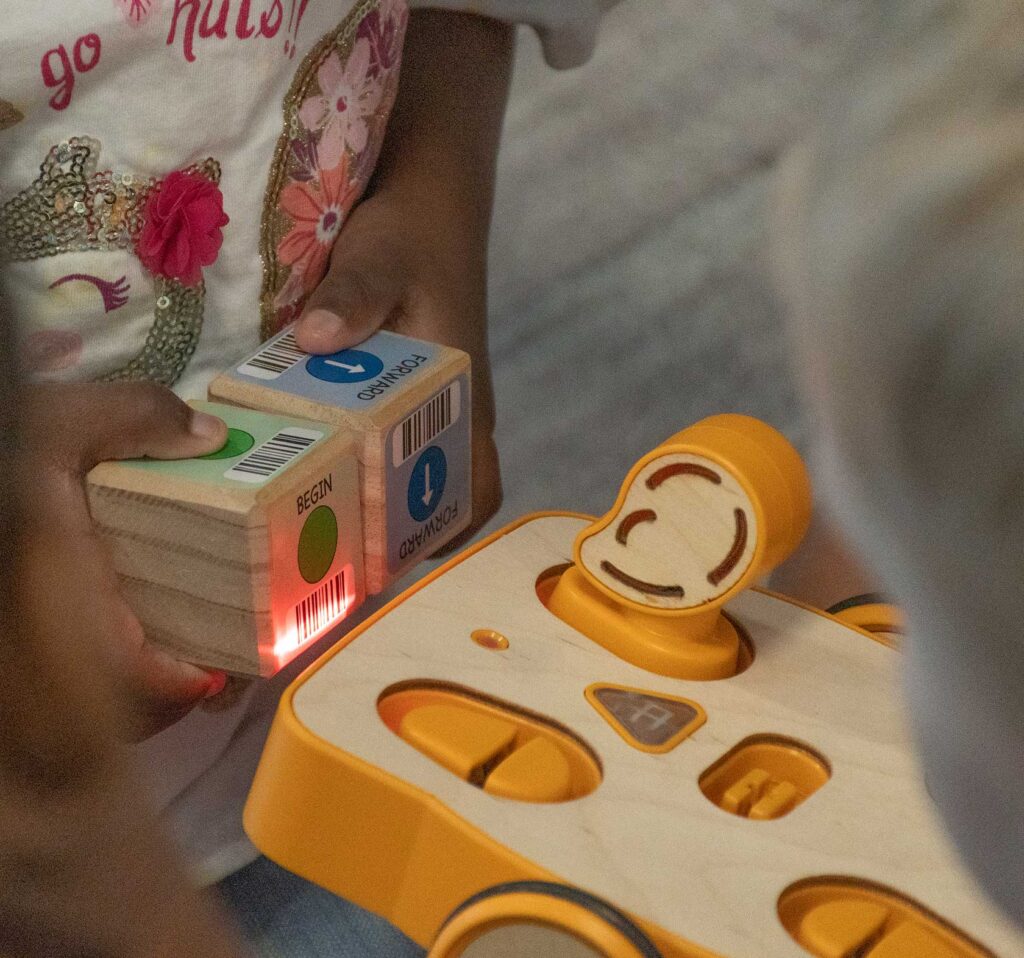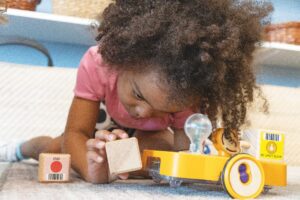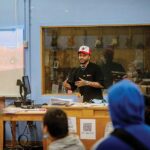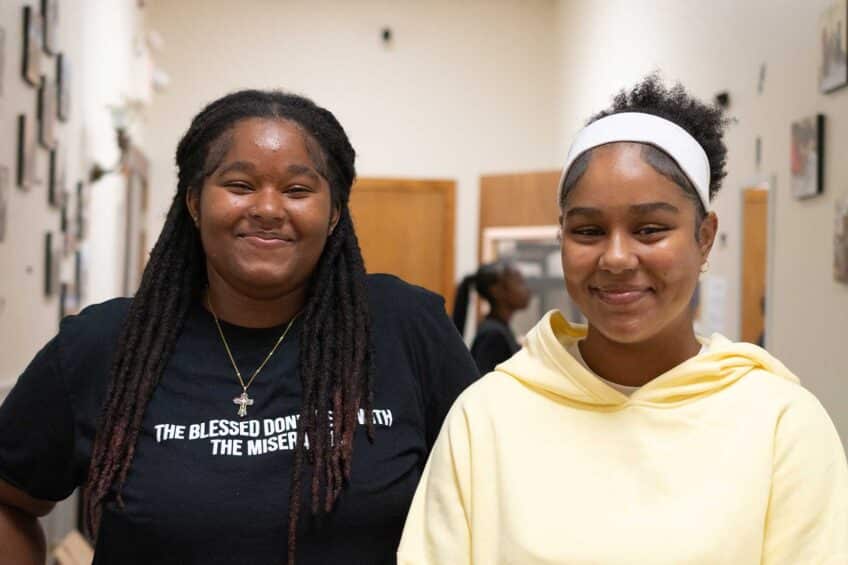
On a sunny Tuesday morning, light pours over the pre-kindergarten students clustered on a rug playing with wooden building blocks in their Roxbury day care classroom.
But they aren’t building a tower with the blocks they’re stacking. Instead, they’re writing a line of code, and the little robot on the rug in front of them knows what to do, moving and shaking and flashing with multicolored lights.
This lab space — dedicated to science, technology, engineering and mathematics programming — isn’t your normal lab, and the kids exploring coding through the building-block robots are the kinds of kids who often are the most likely to be left out of opportunities in these fields, known by the shorthand STEM.

A preschooler programs a KIBO robot
with a block during a coding lesson. BANNER PHOTO
The lesson with the KIBO robots — which took place simultaneously in English and Spanish — is part of a curriculum at Horizons for Homeless Children center in Roxbury, designed to better prepare children experiencing homelessness in low-income families for future education and beyond.
“This whole experience is about mitigating the impact of the trauma and making sure that when they leave here, they’re going off to school ready, socially and emotionally regulated, and rockin’ and rollin’ and ready to learn,” said Kate Barrand, CEO of Horizons.
The task is not a small one. Data has found that, in Massachusetts, one out of 19 families with kids under 6 experience homelessness, and Barrand said that, given the multi-year timeline to collect and process those numbers and recent struggles in the state to house new migrants, those numbers are probably higher.
But staff at Horizons are confident that their work with students 5 years old and younger who are living in shelter settings is having an impact.
“There’s a lack of resources that they have at this young age if they are of color and are in poverty,” said Shavon Drayton, director of early education training and assessment at Horizons. “Being able to offer them the exposure at a very kind of fundamental way is really what will provide them the opportunity to have a level playing field once entering kindergarten.”
Tackling bias, closing gaps
Early STEM education can also break down biases around who has aptitude for the field, in a way that can empower youth, said Bonnie Bertolaet, executive director of Science Club for Girls, a Cambridge-based nonprofit that runs afterschool STEM programming for girls and gender-expansive youth as young as kindergarten. Research has shown that bias in who performs well in STEM disciplines and who doesn’t starts young.
“Harnessing that joy and wonderment and coupling it with power to make sense [of the world] is really important for children who have a lot of stresses in their lives,” said Bertolaet, whose organization is not affiliated with Horizons. “Having the power of STEM to make sense of your world is incredibly empowering and liberating. It gives you more sense of autonomy when you might not feel it in other areas of your life.”
It’s also about closing broader gaps in STEM fields later in life, Barrand said.
“If a child isn’t exposed to and doesn’t have a dream about the potential, then they’ll never get those jobs,” she said. “If you talk to folks who’ve grown up in poverty, what they describe is a lack of experience and exposure.”
Across the city and state, other organizations are working to close gaps in diversity in fields like the life sciences for adults.
In Dorchester, Bioversity, a workforce-development program focused on lab operations, launched in January and has since graduated two cohorts of students. A life science training center will be included in the upcoming Nubian Ascends development in Nubian Square. And last winter, the city of Boston announced $4.7 million in investments to programs attempting to bring parity to the field.
But Bertolaet said those programs, targeted at adults looking to grow or change their careers are only part of the puzzle, and just as much focus should be directed at early STEM education.
“We need to have long-term investment and start young in STEM education and continue to support it, so that we can truly have women and people of color represented at all levels of the STEM ecosystem, including the higher levels in terms of position of influence and range of salaries,” she said.
Data from a November report published by the Massachusetts Biotechnology Council showed that in life science fields in the state, there are greater gaps in representation for people of color in executive leadership positions than in the general biotech workforce.
Early start is key
An early start, Bertolaet said, is important for showing children, from a young age, that people from communities currently underrepresented in science fields can have just as much of a role in the STEM fields.
“We know that underrepresentation is not due to a lack of interest or, as crazy as it sounds, a lack of aptitude, but it’s due to a lack of access,” she said.
Education for children can also result in increased exposure for the adults in their life. Barrand called the early STEM education at the Horizons Center “fertilizing the soil” and said it can help their parents see more possibilities too.
“It’s pretty magical what happens in there, and I think it’s magical for the parents as well,” Barrand said. “If we can teach them that a 3-year-old can code, maybe it opens the door for them to say, ‘I wonder if I could learn how to code.’ And the answer is, yeah, given the right exposure, I’m sure they could.”
At Horizons for Homeless Children, that sentiment goes alongside a so-called “two-generation model” that the organization uses, not only offering care and education for the kids, but providing the adults training in areas like parenting, financial skills and language access.
Developing a STEM curriculum for young kids requires some different approaches to the work. Instead of worksheets and exams, it’s about bridging high-level knowledge with simple and fun mechanics that can click with the age group.
Leadership at Horizons said much of that success comes from partnerships with outside organizations, like the DevTech Research Group at Boston College, which develops the KIBO robots children at Horizons use, or the Museum of Science, which supports Horizon’s engineering programming.
“Being able to have the scientists and those that have that high-level knowledge of being able to code … partnering with us to be able to make sure that it’s simple, that it’s fun, that it’s able to be understood by a 3- or 4-year-old, is really the beauty of it,” Drayton said.
Barrand described the partnership approach as, “You can’t be good at everything.”
“What we know how to do is early education,” she said. “That’s our center line here at Horizons; that’s our skill set. But when we want to dive in and enrich our program, we go find the best practices that are out there.”
‘Naturally born scientists’
For kids, hands-on and experimental activities tend to lead to eager engagement, Bertolaet said.
“When you make science content relatable to [kids’] lives, they are literally knocking down doors to get at it,” she said.
If it’s done right, the impact can be significant. Barrand pointed to child development research that suggests a kid’s brain is, in many respects, almost fully wired by age 5.
“You really want to wire it well, and the way that children’s brains get wired is by interacting with people and things,” Barrand said. “The challenge of parents experiencing homelessness and living in deep poverty is that their whole focus is survival, so it is very hard for them to be as present as they might want to be or need to be for their child.”
But kids are well-prepared for the classes, with the kinds of interaction that young children do when trying to understand their brand-new world — asking questions like “Why are leaves green?” and “Where do butterflies come from?” or wanting to order and categorize things — making for natural engagement with STEM concepts, Bertolaet said.
“This is a huge part of children’s lives, and it’s definitely at the basic fundamentals of STEM,” she said. “They are naturally born scientists, and so it’s not even something that we have to create; we just have to give the support and the environment to really foster and grow it.”






